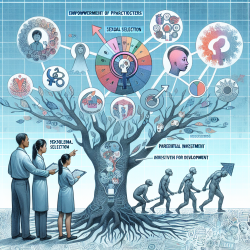Introduction
In the field of speech-language pathology, understanding the dynamics of family structures can significantly enhance the effectiveness of therapeutic interventions. The research article "Sexual Selection and the Treatment of Predecessors’ Progeny by Replacement Mates" provides valuable insights into the behavior of stepparents and the variability in their investment in stepchildren. This blog explores how practitioners can leverage these findings to improve outcomes for children in stepfamilies.
Understanding Stepparental Behavior
The research highlights the variability in stepparental investment, ranging from rejection to full adoption of stepchildren. This variability is influenced by ecological and demographic factors, such as the availability of mates and the stability of pair bonds. For practitioners, recognizing these factors can be crucial in tailoring interventions to support positive family dynamics.
Application in Practice
Practitioners can utilize these insights by:
- Identifying Risk Factors: Understanding the ecological and demographic variables that influence stepparental behavior can help practitioners identify families at risk of negative outcomes.
- Promoting Positive Interactions: Encouraging stepparents to engage in positive interactions with stepchildren can foster better relationships and improve child outcomes.
- Supporting Stepfamilies: Providing resources and support to stepfamilies can help mitigate the challenges associated with stepparenting and promote healthier family environments.
Encouraging Further Research
The research article encourages further exploration into the predictors of stepparental investment. Practitioners are urged to consider the following areas for future research:
- Impact of Local Demographics: Investigating how local sex ratios and marital stability affect stepparental investment can provide deeper insights.
- Child Attributes: Understanding how child attributes influence stepparental behavior can inform more personalized interventions.
- Longitudinal Studies: Conducting longitudinal studies to track changes in stepparental investment over time can reveal patterns that inform practice.
Conclusion
By integrating the insights from sexual selection theory into practice, speech-language pathologists can enhance their understanding of stepfamily dynamics and improve outcomes for children. Embracing a data-driven approach and fostering positive stepparental relationships are key steps toward achieving this goal.
To read the original research paper, please follow this link: Sexual Selection and the Treatment of Predecessors’ Progeny by Replacement Mates.










